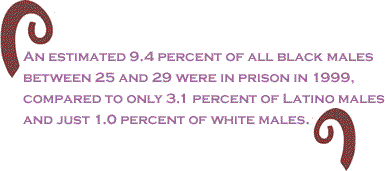
|
|||||||||||||||||||||
 |
There is now little doubt that there is a close correlation between the "war on drugs" (and on "gangs") and the growth of the prison industrial complex. This "war" was officially launched by President Reagan in the mid-1980s when he promised that the police would attack the drug problem "with more ferocity than ever before." What he did not say, however, was that the enforcement of the new drug laws "would focus almost exclusively on low-level dealers in minority neighborhoods." Indeed, the police found such dealers in these areas mainly because that is precisely where they looked for them, rather than, say, on college campuses. The results were immediate: the arrest rates for blacks on drug charges shot dramatically upward in the late 1980s and well into the 1990s. In fact, while blacks constitute only around 12% of the U.S. population and about 13% of all monthly drug users (and their rate of illegal drug use is roughly the same as for whites), they represent 35 percent of those arrested for drug possession and 74% of those sentenced to prison on drug charges. The evidence of racial disproportionality in
the drug war is overwhelming. For instance, arrest rates for
minorities went There has been a dramatic increase in the number and percentage of blacks who are incarcerated in America's prisons, amply documented in numerous sources. Drug convictions accounted for almost half (47.5%) of the total prison growth between 1995 and 2001 in the federal system. One recent estimate is that convictions for drugs accounted for almost one-half of the increase in state prison inmates during the 1980s and early 1990s. According to the latest federal prison figures (year-end 2002), drugs accounted for 55 percent of all offenders.
One might assume that this is largely a result of the “unintended consequences” of the ongoing drug war in American society. On the other hand, given the fact the drug war has been ongoing since at least the early 1980s, we are concerned that the reason for the increase in the number of blacks incarcerated is more sinister than simply the result of a failing drug war, and questionable racist laws (e.g., crack cocaine v. powder cocaine). It may be plausible to argue that the “war on drugs” (and the “war on gangs”) has actually been a “success” if the aim was to control the surplus population, especially blacks. We are suggesting that this apparent onslaught may actually be attributed to institutional segregation or apartheid practices. The “war on drugs” began to have its effects on jail and prison populations by the late 1980s and early 1990s. Data on court commitments to state prisons during the 1980s and early 1990s clearly show the dramatic changes for drug offenses. Between 1980 and 1992 sentences on drug charges increased by more than 1000 percent! In contrast, there was a more modest increase of 51 percent for violent offenses. Race played a key role in these increases, especially during the late 1980s and early 1990s as the number of blacks sentenced to prison for drug charges increased by over 90 percent, almost three times greater than white offenders. Between 1985 and 1995 the number of black prisoners who had been sentenced for drug crimes increased by 700%.
Not only were more blacks sentenced for drug crimes, but the severity of their sentences increased compared to whites. In 1992, in the federal system, the average sentence length for black drug offenders was about 107 months, compared to 74 months for white drug offenders. There has been a huge discrepancy when comparing powder and crack cocaine sentences in the federal system. In 1995, for instance, blacks constituted a phenomenal 88 percent of those sentenced for crack cocaine, compared to less than 30 percent of those sentenced for powder cocaine. Sentencing in the federal system for drug offenses shows some startling changes during the past half century. Between 1945 and 1995, the proportion of those going to prison for all offenses rose from 47 percent to 69 percent, compared to a decrease of those granted probation (from 40% to 24%), while the average sentence has risen by over 300 percent. The changes in the sentences for drug law violations are most dramatic. Whereas, in 1945 the percentage of drug offenders going to prison was high enough at 73 percent, by 1995 fully 90 percent were going to prison! And the average sentence for drug cases went from only 22 months in 1945 to almost 90 months in 1995, an increase of 300 percent! Finally, while in 1980 the most serious offense for those admitted to federal prison was a violent crime in about 13 percent of the cases and a drug offense in just over one-fourth of the cases, by 1992 in almost half of the cases (48.8%) the most serious offense was drugs, compared to a violent crime in less than eight percent of the cases. In the meantime, the average maximum sentence declined for violent crimes (from 125 months to 88 months) and almost doubled for drug offenses (from 47 months to 82 months). The most recent data show that in 2002 over half (55%) of all federal prisoners are serving time for drug offenses, compared to only 16 percent in 1970 (a 244% increase between 1970 and 2002) and 25 percent in 1980; of all black males in the federal prison system 60 percent are in for drug offenses, compared to 51 percent of white males; blacks currently constitute 46% of all drug offenders in the federal system. It is interesting to note that the proportion of both white and black females in federal prison for drug offenses is about the same – 67% of white women and 65% of black women are in for drugs.
Although somewhat dated, one of the most recent sources of data on court cases comes from a U.S. Department of Justice report which examined felony defendants in the largest 75 counties in 1994. Here we can see the effects of the “war on drugs” and its impact on the nation's court system; we also can clearly see the effects of race. The most serious charge in just over one-third (34.6%) of the cases was a drug offense, with non-trafficking drug offenses being the most common (58% of all drug charges), followed closely by a property crime (31.1%), with about one-fourth (25.7%) being violent offenses, mostly assaults (constituting 45% of all the violent crimes). During fiscal year 2001, there were 24,299 drug offenders sentenced in U.S. District Courts. The most common drug, not surprisingly, was marijuana (one-third of all cases). Whites constituted only 26 percent, while Latinos made up 43 percent and blacks were 31 percent. Not surprisingly, race figured prominently in the cases in the 1994 study. Blacks constituted over half (56%) of all defendants and 62 percent of those charged with drug offenses. Another study noted that almost all (99%) drug trafficking defendants between 1985 and 1987 were blacks. In some cities, the proportion of felony defendants who were black was incredibly high. For example, blacks constituted 93 percent of all felony defendants in Wayne County (Detroit), 90 percent in Baltimore and 85 percent in Cook County (Chicago) and Kings County (Seattle).
A common illustration of the racial bias in drug laws is “crack” cocaine. The penalty for possession and/or sale of crack cocaine is far greater than for the powdered variety of cocaine. It just so happens that crack is far more likely to be associated with blacks. Little wonder that the enforcement of drug laws have been one of the major reasons the prison population has increased so rapidly in recent years. In fiscal year 2001, of all of those sentenced to federal prison for crack cocaine, 83 percent were black, compared to only 7 percent for whites and 9 percent for Latinos. For powder cocaine, the discrepancies are not nearly so stark: half of those sentenced for this drug were Latinos, while only 31 percent were black and 18 percent were white. Put somewhat differently, of all blacks sentenced to federal prison for drugs, 59 percent were convicted for crack cocaine; only 5.5 percent of whites were sentenced for this drug. Going to Prison Becoming the Norm for Blacks and Latinos For most minority youth growing up in urban areas, there is a general assumption that they will end up in jail or prison someday. After all, most of them see family members, friends and relatives being accosted by the police, placed in handcuffs and taken to the local jail almost every day. The following figures reinforce this perception, especially among black youth. An estimated 9.4 percent of all black males between 25 and 29 were in prison in 1999, compared to only 3.1 percent of Latino males and just 1.0 percent of white males. More importantly, however, is the fact that going to prison or jail seems to have become a normative feature in the lives of blacks and Latinos. One method of measuring the extent of the incarceration of racial minorities is to look at the percent of the adult population incarcerated at least once in their lifetime. According to a Department of Justice study, in 1970, less than 1 percent of all whites had experienced a term in a federal or state prison, compared to 4.5 percent of all blacks and 1.3 percent of all Latinos. About 10 years later (1986) whites were still less than 1 percent likely to go to prison, but over 5 percent of blacks and two percent of all Latinos were. By 2001, the latest estimates available, whites still had a low percent of ever going to prison (1.4%), but almost 9 percent of blacks and over 4 percent of Latinos did.
Even more revealing are statistics concerning the lifetime chances of going to prison. According to another Department of Justice study, blacks born in 1974 had a 7 percent chance of going to prison sometime in their lifetime, compared to only 1.2 percent of all whites. For white males born in 1974, the chance of going to prison stood at only 2.2 percent, but it was 13.4 percent for black males and 4 percent for Hispanic males. Seventeen years later, with the drug war in full swing, these percentages had changed dramatically: for all blacks born in 1991 there was a 16.5 percent chance of going to prison, compared to 2.5 percent of whites; however, for black males the chances of going to prison had more than doubled to 29 percent, with a more modest increase for white males to 4.4 percent (technically, it doubled for white males, but the starting percentage was so low as to make this meaningless compared to black males). Perhaps the most dramatic changes, and largely unnoticed in the press and within criminology, was the fact that the chances of going to prison for Latino males quadrupled from 4 percent to 16.3 percent. By 2001, a black male child born that year had an almost one-third chance of going to prison, compared to just fewer than 6 percent for a white male child and a 17.2 percent chance for a Latino male child. The fact that so many blacks have been sent to prison in recent years has a significant impact on their voting rights. A recent study found that while two percent of all adults have been disenfranchised because of a felony conviction (mostly drug convictions), about 13 percent of all black men have been! In six states the percentage of black men disenfranchised is 25 percent or more, going higher than 30 percent in Alabama and Florida (and we all know what happened in Florida in 2000). We need not elaborate the obvious any further, for the fact remains that the "war on crime" and the "war on drugs" targets disproportionately racial minorities, who find themselves in alarmingly increasing numbers behind bars and generally subjected to the control efforts of the criminal justice system. The situation is not likely to improve, especially as long as federal, state and local governments continue to increase the money used for the crime control industry, instead of for prevention. With increasing attention given to our reaction to crime, the attention given to the ultimate sources of crime will decrease, only exacerbating the problem further. Anyway you look at it, going to prison has become a very common experience for racial minorities. And these figures do not include their chances of being arrested and booked into jail or a detention center in the case of a juvenile. In Part III of this series we discuss two other examples of the new American apartheid: the jailing of minority juveniles and women. Click here to read Part 1 of this series. Click here to read Part 3 of this series. Click here to read Part 4 of this series. Randall G. Shelden and William B. Brown are Professors of Criminal Justice at the University of Nevada-Las Vegas and Western Oregon University respectively. They have written several books on crime and criminal justice. This essay is part of a forthcoming book on the prison industrial complex. Shelden may be contacted via his web site: http://www.sheldensays.com. A more detailed version of this series, including references and footnotes, can be found on this web site. |
July
15 2004 |
|||||||||
|
|||||||||
|
|
|||||||||
| Printer Friendly Version | |||||||||
 |
|||||||||
| |
|||||||||
| |
|||||||||






























